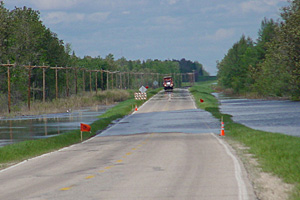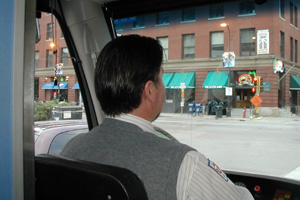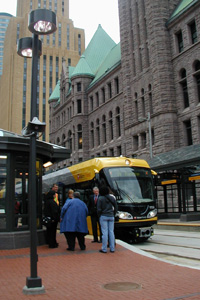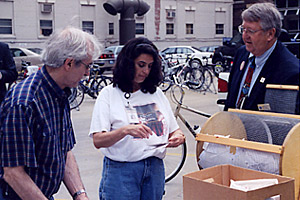 |
 |
|
 |
Joint flood control efforts help Roseau avoid devastation it suffered in 2002
|
 |
 |
 |
A crew from the Roseau Truck Station rolls out to deal
with flooding on Hwy 310 north of Roseau.
Photo by Curt Larson
|
This spring, staff from the Crookston Maintenance Area found themselves where
they often are: knee- (or higher) deep in dealing with floodwaters in the state’s
northwestern region.
As they did in 2002, maintenance forces from Roseau and neighboring truck stations
joined other agencies and volunteers to minimize effects from the flooding Roseau
River.
Their efforts helped avoid a repeat of the 2002 floods that caused extensive
damage in Roseau.
Floodwaters from the river and the Sprague Creek that rises in Canada forced
closing Hwy 310 for more than a week between Roseau and the Canadian border,
said Curt Larson, Roseau Truck Station supervisor.
Larson said flooding covered part of Hwy 11 east of Warroad for several days
but workers from Roseau kept traffic moving by flagging motorists through the
water-covered areas of the highway.
When they weren’t working on their own jobs, Larson said crewmembers
from Roseau volunteered to do sandbagging and other flood-control tasks.
Roads such as Hwy 310 suffered only minor damage, Larson said, because the
waters were slow moving and didn’t undermine the shoulders or the driving
lanes. Damage was limited to field access roads for farmers and to some drainage
ditches.
"We’ll get out there to start fixing things as soon as it’s
dry enough to work," Larson said.
Larson's businesslike attitude reflects that of department employees who calmly
do what needs to be done when natural disasters or other calamities strike.
Assistance provided by Mn/DOT employees at Roseau, previous floods and other
natural disasters such as the tornado that devastated St. Peter in 1995 drew
praise from James Halstrom, president of the Association of Minnesota Emergency
Managers, and Terri Smith, assistant director of Public Safety’s Division
of Homeland Security and Emergency Management.
"It’s important to recognize the Mn/DOT districts’ efforts,”
he said. Halstrom, who worked with Mn/DOT employees following the St. Peter
tornado, added, “Mn/DOT staff were outstanding and served as the workhorses
in cleaning up after that disaster."
Smith said inter-agency cooperation was a key element in reducing the flood’s
effects.
“The people of Roseau and all the agencies that played a role in saving
the city did a tremendous job,” she said. Smith said assistance from Mn/DOT,
the U.S. Army Corps of Engineers and flood control measures the city took coupled
with countless hours of volunteer work helped avert a disaster like the 2002
floods.
“Thank you,” Smith said. “You all make Minnesota the great
state that it is."
By Craig Wilkins
|
back

|
 |
Early backers of light rail transit get a preview ride on the Hiawatha line
|
 |
 |
 |
Stephanie Eiler, a project manager with a consulting firm (at right),
describes the LRT route to Aaron Vap, Alicia Vap, a planner with the
Metropolitan Council, and their daugher Eleanor during their first trip
on the line.
Photo by Craig Wilkins
|
People involved in planning, designing and building the new Hiawatha light
rail transit line during the past 30 some years stepped aboard the trains May
25 for a preview ride, just one month before service on the line begins.
Once aboard the sleek yellow, black and silver trains, the guests were whisked
smoothly away from the Government Plaza station near the Minneapolis City Hall
and headed for the stations at the Metrodome and the Cedar-Riverside area. Once
out of downtown, the train joined the alignment of Hiawatha Avenue (Hwy 55)
and passed heavy late-afternoon vehicle traffic as it picked up speed on the
way to the station at Fort Snelling.
Service between downtown Minneapolis and Fort Snelling begins June 26. Service
to the Mall of America and the Minneapolis-St. Paul International Airport is
scheduled to begin in December. When the full line is open, it will include
17 stations along its 11.6-mile route.
During a reception at the Hennepin County Government Center, guests heard from
current and former legislators, other government officials, business executives
and community leaders who led the sustained effort to create the LRT line in
the Hiawatha corridor.
 |
Train operator Brad Cummings eases the train into the station in the
Warehouse District in Minneapolis.
Photo by Katie Simon Dastych
|
The Metropolitan Transitway Development Board sponsored the event.
Peter Bell, chair of the Metropolitan Council, the agency that operates the
new line, noted that LRT service will start 50 years after the demise of the
region’s trolley system.
“We’ve overcome obstacles such as politics, funding and operating
LRT in Minnesota’s climate,” he said. “But Hiawatha became
the train that could not be denied. We have a received a lot of support to make
this happen.”
Susan Haigh, a Ramsey County commissioner and MTDB official, commended those
whose “talent, tenacity, patience and political skills” led to the
line’s creation.
By Craig Wilkins
Retired trolley operator among first to ride the Hiawatha LRT
Among the hundreds of guests from government agencies, consulting firms, and
businesses was A. J. Block, 82, a retired streetcar operator.
 |
Passengers wait to board the Hiawatha LRT at the Government Plaza station
in downtown Minneapolis.
Photo by Katie Simon Dastych
|
Block, now retired, recalled that in the fall of 1953, a woman got on his streetcar
in Minneapolis, asking if it went to St. Mary’s Hospital. Shortly after
boarding, Block said, it became very apparent she was about to give birth.
Block stopped the trolley at Lake Street and Minnehaha Avenue, sounded his
horn and rang his bell to alert nearby police officers that he needed help.
The officers took the woman to the hospital. Block later learned she had given
birth to twins.
“She should have named them ‘Streetcar’ and ‘Trolley,’”
he said.
Block said he was very pleased to see the return of light rail service.
“This is exciting,” he said, “Maybe not as exciting as the
lady having twins, but very exciting.”
|
back

|
 |
Senate approves appointment of Lt. Gov. Molnau as transportation commissioner
|
 |
 |
Lt. Gov./Commissioner Carol Molnau’s position as transportation commissioner
was confirmed by the full Minnesota Senate on May 16 in the waning hours of
the 2004 Legislative session.
Molnau’s confirmation had been in doubt because an earlier vote on March
30 by the Senate’s Transportation Finance Committee failed to support
her confirmation.
Molnau, former chair of the House Transportation Committee, was appointed as
transportation commissioner by Gov. Tim Pawlenty after their election in 2002.
Before her election as lt. governor, Molnau served five terms in the House
representing the Chaska area. She led the transportation committee during her
last two terms.
Molnau is the first lt. governor in Minnesota to fill a commissioner’s
position in addition to her elected one.
“I am glad that I now stand as Minnesota’s confirmed transportation
commissioner and that the confirmation process is now complete,” she said.
“I am proud to lead Mn/DOT as we move forward with our business of providing
Minnesotans with a great transportation system.”
|
back

|
 |
New Web site enables employees to get some prescription drugs without cost |
 |
 |
More than 300 state employees have registered to order free prescription drugs
via a new effort to lower health care costs for 48,000 state employees and their
dependents, said Paul Strebe, a health policy analyst with the Department of
Employee Relations.
The drugs became available at no cost to state workers as a part of Gov. Tim
Pawlenty’s initiatives to control prescription drug costs for all Minnesotans
by purchasing the medications in Canada.
In 2003, the state spent $362 million for health care coverage. Of that total,
about 20 percent ($74 million) was spent for prescription drugs.
Employees may register for the program at the Web site established May 13 by
DOER.
The drugs are available only to people enrolled in the Advantage plans: Health
Partners, Preferred One and Blue Cross/Blue Shield.
Strebe said the selection of drugs available from the program is limited but
includes about 8 of the 10 most frequently prescribed medications. Advantage
plan members may check the list of available drugs and order the prescriptions
they need; the state will reimburse the pharmacy. To encourage participation
in the program, members will not be charged the customary drug co-payments for
drugs purchased in Canada.
Brand name drugs available through the program include those used to treat
high cholesterol, acid reflux syndrome, depression and joint inflammation which
are included in each plan’s formulary, the drugs it regularly dispenses
to patients.
Strebe said information about the program and a list of available drugs are
also available at the DOER Web site: www.advantage-meds.com
.
|
back

|
 |
U. S. Supreme Court lets rulings affirming DBE programs stand |
 |
 |
Programs that establish participation goals for women- and minority-owned contracting
firms operated by the Minnesota and Nebraska DOTs were found to be constitutional
May 17 by the U. S. Supreme Court.
The high court upheld findings in favor of the states by federal district courts
and the
U. S. Court of Appeals. The court did not rule on the issue, however; it left
the ruling by the Court of Appeals stand that validated the states’ programs.
The lawsuit against Mn/DOT alleging that the state unfairly discriminated against
firms owned by white males through its Disadvantaged Business Enterprise program
was filed by Sherbrooke Turf Inc., a landscaping firm in Pelican Rapids.
A Nebraska contractor sued on similar grounds.
The issue of DBEs has been addressed by the courts frequently. In 1995, for
example, the Supreme Court said the Constitution’s Equal Protection Clause
expressed by the 14th Amendment requires that affirmative action programs be
“narrowly tailored” to meet a “compelling” interest.
Federal rules also require states to reach their goals through race-neutral
means before they can use preferences for disadvantaged businesses.
The Bush Administration said the program serves as a remedial effort established
by Congress to compensate for a long history of discrimination in the industry.
Congress reauthorized the program in 1998 when it was included in the Transportation
Equity Action for the 21st Century.
Following the legal challenge by Sherbrooke in 1995, court orders required
that Mn/DOT cease operating its DBE program in 1998. Operating under revised
federal guidelines, the program was re-instated for the 2001 fiscal year.
"The fact that Mn/DOT withstood this legal challenge is great news,”
said Joanne Wagner, director, Office of Equal Employment Opportunity/Contract
Management. “It’s a clear indication that this agency is on the
right track to create a level playing field on which DBE firms can compete fairly
for contracts funded by the U. S. Department of Transportation.”
By Craig Wilkins
|
back

|
 |
B-BOP events focus on finding alternatives to driving solo |
 |
 |
What is the real cost of driving to work or school alone?
Mankato/District 7 employees took the B-BOP (bike, bus or pool) Commuter Challenge
last week and went to the Metro Commuter Services Web site www.metrocommuterservices.com/costcal.asp
to find out. Employees who completed the calculations won a prize.
 |
Jean Meyer, District 6 transit coordinator, holds a
prize drawing with Cory Landgren of IBM (at left) and Mayor Ardell Brede
at the B-BOP Day celebration in Rochester.
Photo by Brian Jergenson
|
This was one of many events held statewide on B-BOP Day, May 20, and throughout
the month of May to encourage commuters to use alternate modes of transportation.
In Rochester, District 6 Engineer Nelrae Succio, Mayor Ardell Brede, legislative
and city council members participated in an event downtown sponsored by the
city of Rochester, the Mayo Clinic, IBM and Mn/DOT.
They handed out free donuts and coffee to transit users as they got off the
bus.
Tracy McCray, a reporter for radio station KROC, conducted live interviews
with riders and dignitaries on a popular bus route; the mayor and Brian Jergenson
Rochester District 6 public affairs coordinator, also gave donuts away.
Rochester employees who pledged to try an alternative form of transportation
this year were eligible to win prizes including a trip for two on Amtrak to
Glacier National Park, a Grouse Mountain Lodge stay, a new bike, gift certificates
and free bus passes.
On May 12, a representative from the B-BOP Metro Area Commuter Challenge, organized
by the Metropolitan Council, visited the Metro District’s Waters Edge
Building to encourage employees to take the commuter challenge and sign up for
prizes.
Capitol complex employees took the commuter challenge on B-BOP day during a
Walk Around the Capitol. About 264 walkers participated, including 152 Mn/DOT
Central Office employees. Walking achievement awards went to the Legislative
Reference Library for being the state agency with the highest percentage of
participation, 62.5 percent; the Mn/DOT Office of Land Management for being
the team with the most total laps, 82; and the Department of Administration
who had a walker who completed the most laps, four. Winners received incentive
prizes and refreshments. The Hiway Federal Credit union provided cookies and
water and the Tour de Cure, Metro Transit, and St. Paul TMO provided info on
commuting options during the event.
So, how much does it cost to drive alone to work for one year? Calculations
on the Metro Commuter Services Web site do not take into consideration the current
rise in gas prices.
The site used a cost per gallon of $1.25 to get to a final annual cost of driving
alone of about $3,000.
Darryl Anderson, bicycle coordinator, Office of Transit, did some additional
calculations using a cost per gallon of $2. He also made some adjustments using
more current rates for parking, insurance and vehicle purchase costs to arrive
at an annual cost of driving alone closer to $4,000.
There are, of course, additional savings to B-BOPing that include reduced traffic
congestion and air pollution and stress relief.
By Donna Lindberg
|
back

|
 |
Mn/DOT shares ITS expertise at China forum |
 |
 |
Minnesota’s intelligent transportation system initiatives received international
exposure at the China 2004 Forum on Intelligent Traffic held in Beijing April
18-20.
The forum brought together senior Chinese government officials from the Ministry
of Public Security and Ministry of Science and Technology, industry representatives
from the United States and Europe, and other international ITS experts and scholars.
Lt. Gov./Commissioner Carol Molnau and Marthand Nookala, Operations, Safety
and Technology Division director, were invited to present on “Traffic,
ITS and Partnerships in Minnesota” at the forum—the first such forum
held in China.
“Minnesota was asked to come and share our technical knowledge because
we’re recognized internationally as a leader on intelligent transportation
systems,” said Molnau, who represented Minnesota in her dual role as lieutenant
governor and state transportation commissioner. “We hope this trip also
will open doors for Minnesota businesses in China.”
Molnau presented on Mn/DOT’s ITS partnerships, funding and benefits.
Nookala talked about several of Minnesota’s ITS initiatives, including:
- 511 traveler information system
- Variable message signs
- Traffic cameras
- Low-volume, highway-rail crossing warning system
- Safeplow intelligent vehicle initiative
- Road sensors
Molnau said the forum participants especially were interested in the use of
the Opticom traffic control system, which allows emergency vehicles to request
and receive green lights as they go to and from emergency scenes. Minnesota-based
3M, which has a factory in Shanghai, manufactures the product.
“They were very receptive to understanding our safety technology,”
said Molnau, who noted the large number of traffic-related deaths in Shanghai.
In addition to making a presentation at the ITS forum, Molnau and Nookala also
were asked to give their presentation to two other groups—to safety engineers
and to highway patrol students.
Nookala said that the students were amazed, not necessarily because of the
technology.
“They wondered ‘How can you do these government partnerships and
public-private partnerships without fighting?’” he said.
The forum was organized by the Ministry of Public Security and Ministry of
Science and Technology of the People’s Republic of China and hosted by
the China Road Traffic Safety Association and the China Public Security University.
By Chris Joyce
|
back

|
 |
Lt. Gov. Molnau notes Waters of the Dancing Sky Scenic Byway’s value to
area communities
|
 |
 |
Lt. Gov./Commissioner Carol Molnau recognized the significance of Minnesota’s
northernmost scenic byway, the Waters of the Dancing Sky, during Minnesota’s
Fishing Opener May 14-16 near Baudette.
The scenic byway runs along 229 miles of Hwy 11, from Island View to the North
Dakota border. It connects manufacturing companies to distributors, timber haulers
to sawmills and agricultural products to growers. It also provides strong ties
with neighboring states and Canada.
On a boat tour of the Rainy River that parallels Hwy 11, Molnau talked with
representatives from the local scenic committee and byway communities along
the route.
"The Scenic Byways Program is an example of state agencies working with
communities and citizens to develop routes that reflect the true spirit of our
state,” she said. “The Waters of the Dancing Sky Scenic Byway links
travelers with some of the best recreation the state has to offer. It is also
an important interregional corridor that helps support our economy."
Minnesota's Scenic Byway Program began in 1992 as a partnership between Mn/DOT
and three other state agencies to promote cooperative projects with communities,
tourism organizations and state agencies that are linked by scenic byways.
Projects including roadside improvements, interpretation, marketing and historic
preservation enhance the state’s roadways to support the tourism industry
while serving as vital commercial corridors. Since the program began, 20 Minnesota
scenic byways have been designated totaling 2,304 miles. Scenic Byways have
achieved success by integrating environmental and recreational values with local
road improvement programs, said Mark Anderson, Mn/DOT Scenic Byways program
coordinator, Environmental Services.
"Local communities are very proud of the Waters of the Dancing Sky Scenic
Byway,” Molnau added. “Scenic byways remind us that recreation is
not just our destination. It’s also the roads we travel to get there,
the unique quality of the towns we pass through and the people who live in them."
A new Scenic Byways map is available at Target photo stores. The map includes
whimsical illustrations of byway activities by illustrator Mike Wohnoutka and
promotes cultural heritage tourism along Minnesota byways. Also, a direct mail
marketing package will go to 545,000 Minnesota households with information and
incentives to visit attractions along favorite scenic byways this summer.
The Mn/DOT Scenic Byways Web site at http://www.dot.state.mn.us/environment/programs/scenic_byways.html
provides information as does the Minnesota Tourism Office’s Explore Minnesota
Web site at http://www.exploreminnesota.com/go.cfm/byways
and the National Byways Web site
http://www.byways.org/index.html.
For more information about Mn/DOT’s Scenic Byways Program, contact Mark
Anderson at 651/284-3748.
By Donna Lindberg
|
back

|
 |
Civil Air Patrol honors Aeronautics’ Ray Rought |
 |
 |
Ray Rought, director of the Office of Aeronautics, earned recognition from the
Minnesota Wing of the Civil Air Patrol for his and Aeronautics’ support
of the CAP’s mission.
Rought was made an honorary member of the CAP for his contributions.
The air patrol is the official auxiliary of the U. S. Air Force. It performs
missions such as search and rescue, surveillance for disaster relief and transports
blood, donated organs and other time-sensitive medical needs.
Rought has served as director of Aeronautics since his appointment in 1986.
In addition to his Mn/DOT duties, Rought served as president of the National
Association of State Aviation Officials in 1993 and currently serves as a board
member with the NASAO Center for Aviation Research and Education. He also serves
as a member of the National Academy of the Sciences committees on aviation systems
planning and intergovernmental relations in aviation.
Rought, who holds a private pilot’s license, earned a bachelor’s
degree in civil engineering from Michigan Technological University and a master’s
degree in civil engineering from Michigan State University.
By Craig Wilkins
|
back

|
 |
|
 |



